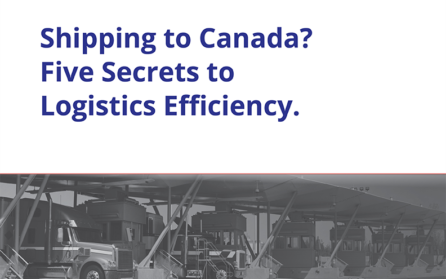White Papers
Shipping to Canada? Five Secrets to Logistics Efficiency

A few facts about U.S. business practices that are somewhat surprising:
- Less than one percent of U.S. businesses are exporters. And of those that do export, 58 percent sell to only one country, usually Canada or Mexico.
- Each year, U.S. businesses fail to apply for an estimated $2 billion in duty drawback funds, which is money to which they are legally entitled.
- 70 percent of companies do not fully utilize free trade agreement (FTAs), which likely means they are paying more than required in tariffs and duties, according to a recent Thomson Reuters/KPMG survey.
Facts like these have puzzled federal and state elected officials and trade administrators for decades. When asked about this lack of involvement, businesses cite a range of explanations including:
- General unawareness about how to export, or take advantage of government programs
- Complexity of application and documentation requirements
- Lack of internal resources to manage an export program or facilitate compliance
- Lack of financing to initiate international growth; and a
- Sense that the U.S. market provides ample opportunities for growth.
While each of these concerns is certainly valid, the fact remains that help is available to overcome essentially every concern or barrier to foreign market entry.
A good place to start is by accessing Export.gov, which is the entry point for all government trade services. Businesses in need of capital to finance an export expansion, for example, will be directed to the U.S. Small Business Administration, which administers loan and financing programs. A business interested in learning more about a particular foreign market may find the U.S. Commercial Service, a division of the Commerce Department, especially helpful. Among other things, the Commercial Service produces “Commercial Guides” that discuss market factors, economic and political considerations, and other key topics for more than 125 countries.
With regard to free trade agreements, help is available to assist businesses in determining if their goods qualify for duty-free status under one of the 13 FTAs the United States currently has in place. The International Trade Administration maintains a “FTA Tariff Tool,” which provides quick guidance with regard to FTA eligibility, based on a product’s tariff classification code.
Duty drawback is a different animal. Drawback refers to the refund of up to 99 percent of import duties, taxes and fees paid on products that are subsequently exported or destroyed. The process was established 230 years ago as a way to encourage U.S. businesses to export, but the filing requirements have become quite complicated.
A business interested in drawback might feel a bit intimidated by a CBP website warning which advises: “Be aware the process of filing for drawback can be involved and the time it takes to receive funds can be lengthy.”
But, since drawback can be claimed on transactions dating back five years, businesses can reap significant windfalls from a successful drawback application. The good news is drawback reform legislation took effect in February, that clarifies and simplifies key parts of the process. In addition, duty drawback specialists are available, and can be reached via one of the CBP’s four drawback center locations.
A new white paper from Purolator International, “Shipping to Canada? Five Secrets to Logistics Efficiency,” delves into these and other less-understood aspects of the international shipping process. As the paper makes clear, expanding to Canada can be a lucrative step for a U.S. business. But critically important, is having a clear understanding of the technical aspects of the shipping process, and familiarity with the various opportunities to improve efficiency and manage costs.
Learn more by clicking here to download a complimentary copy of Purolator’s new white paper.
You must have javascript enabled in your browser to receive the whitepaper successfully